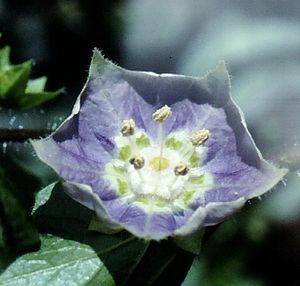Yaltomata andersonii
| Yaltomata andersonii | ||||||||||||
|---|---|---|---|---|---|---|---|---|---|---|---|---|

Flower of Jaltomata andersonii |
||||||||||||
| Systematics | ||||||||||||
|
||||||||||||
| Scientific name | ||||||||||||
| Yaltomata andersonii | ||||||||||||
| Mione |
Jaltomata andersonii is a plant type from the genus jaltomata in the family of the nightshade family (Solanaceae).
description
Vegetative characteristics
Jaltomata andersonii is a highly branched, herbaceous plant that grows to about 20 centimeters high and is likely to be perennial . The hair on young stems and the leaves is glandular. The leaves are usually alternate, rarely in pairs. The leaf blades are usually 4 to 7.5 centimeters long, a herbarium specimen also has up to 10.5 centimeters long leaves; the width is between 2 and 3.5 centimeters. From the midrib, three to four main arteries extend on each side. The tip of the blade is often a little pointed, at the base it is wedge-shaped and symmetrical or almost symmetrical. The upper side of the leaf is densely covered with upright, finger-like trichomes , the underside is only sparsely hairy. The leaf margin is toothed and ciliate with almost the entire margin. The leaf stalks are up to 1 centimeter long.
Inflorescences and flowers
The flowers stand individually on stems 13 to 18 millimeters long, which are not clearly divided into peduncle and peduncle , as is often observed in other species of the genus . The calyx is green, wheel-shaped and measures 16 to 21 millimeters in diameter at flowering time. The calyx lobes are triangular with a pointed tip, on the outside a raised central rib can be made out. The hair on the calyx consists of gland-pointed trichomes up to 3 millimeters long and stalked multicellular glands with a length of 85 to 100 micrometers. The inside is hairy evenly with upright, non-glandular hair with a length of 0.24 to 0.3 millimeters. There are two different types of hair at the edge: glandular trichomes up to 2.8 millimeters in length and non-glandular trichomes 0.1 millimeters in length. The crown is flat, bowl-shaped and measures 3.7 centimeters in diameter, is purple with five dark green spots that form a ring in the center of the flower. Between the spots are the central ribs of the petals, which clearly extend to the edge of the crown. The edge of the crown is ciliate, both sides of the crown are abundantly and evenly covered with stalked multicellular glands 85 to 100 micrometers in length.
The five stamens are 6.9 to 7.2 millimeters long. The stamens are straight and hairy tomentose at the base. The anthers are 1.9 to 2.8 millimeters long on herbal specimens and up to 3.9 millimeters on specimens soaked in alcohol. The stylus is 5.7 to 6.3 millimeters long and measures 0.15 to 0.36 millimeters in its center. With a diameter of 0.21 to 0.3 millimeters (or 0.36 millimeters for specimens soaked in alcohol), the scar is no wider than the end of the stylus. The flower base is wide and encloses the base of the ovary. The entire gynoeceum is hairless, with the exception of papillae 13 micrometers long on the scar. The ovary appears tomentose, but this is due to the thick hair at the base of the stamens.
Fruits and seeds
On the fruit, the calyx enlarges to a diameter of up to 25 millimeters. The color of the ripe fruit is unknown, but it is believed that the berries are orange or red and measure about 12 millimeters in diameter.
Botanical history
The species was first described in 2004 based on a specimen collected in 1998, the epithet honoring Gregory Anderson , the doctoral supervisor of the first descriptor Thomas Mione .
Occurrence
The species occurs on the western slopes of the Andes in the Peruvian departments of Ancash and Lima . There it can be found in treeless, mostly dry and stony habitats at altitudes between 2300 and 3400 meters.
proof
- Thomas Mione, Segundo Leiva G., Leon Yacher: Jaltomata andersonii (Solanaceae): A New Species of Peru. In: Rhodora , Volume 106, Number 926, 2004. pp. 118-123.
Web links
- Jaltomata andersonii on the Jaltomata website of Prof. Thomas Mione (English)